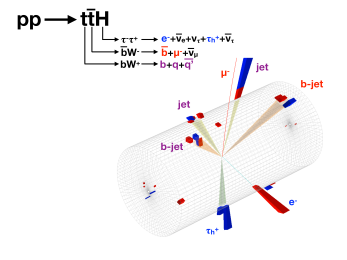Brussels, Monday 4 June 2018: The first observation of the simultaneous production of a Higgs particle with a top quark-antiquark pair was published today in the scientific journal Physical Review Letters. This major milestone, first reported by the Compact Muon Solenoid (CMS) Collaboration in April 2018 and today also reported by the ATLAS Collaboration, unambiguously demonstrates the interaction of the Higgs boson and the heaviest known subatomic particles, and is an important step forward in our understanding of the Higgs boson as the particle that creates the mass that makes atoms in the world around us stable. And up to now the interactions with quarks have not been tested well. As all atoms are made of quarks this means this results has substantial impact in our understanding of the world around us at a subatomic level.

The Higgs particle is expected to interact more frequently with heavy particles than with light particles. Its discovery in 2012 created headlines worldwide and led to the Nobel Prize for Francois Englert and Peter Higgs. The heaviest particle, the top quark, is however not easily made by a Higgs boson because it is actually too heavy. But it is also possible to produce two top quarks and one Higgs particle (see picture, which is an actual collision). This is the production mechanism that has now been observed for the first time, and in doing so, the CMS collaboration accomplished one of the primary objectives the LHC during this decade.
That milestone has been passed considerably earlier than expected”, says UCL professor and EOS be.h spokesperson Fabio Maltoni, who is involved with the theoretical predictions that are necessary to understand this discovery.

One of the challenges of this discovery was to prepare the real-time selection (called trigger) of interesting collision events. Pascal Vanlaer from the ULB has been in charge of this selection and says “We thought of clever ways of using the detector data and, when I saw that they actually worked with the first 13 TeV collisions started, I had a big smile on my face.”
The data analysis was partially performed in Brussels by Kirill Skovpen, FWO postdoc at the Vrije Universiteit Brussel. Skovpen mentions that this effort represents a lively and world-wide collaboration of many excellent physicists coming from the very different expertise fields within the collaboration and the expertise in Belgium is an enormous asset in pursuing an extremely challenging task. Skovpen contributed to the multilepton analysis, the most sensitive part of the data, which made it possible to claim the evidence for this process for the very first time. “With the analysis of new data from the ongoing experiments at the LHC we are firm on our feet to start with the detailed exploration of the interplay between the top quark and the Higgs boson so we can understand this fundamental interaction. These two heaviest fundamental particles may open heavy doors to search for possible answers to yet unresolved questions of the our universe!”, says Skovpen.
Maltoni adds: “and now the way is paved for new exciting experimental and theoretical explorations. Personally, I am also excited because I have started working on the predictions of this process 16 years ago. Actually, back then I proposed (together with two very good friends) looking at 2,3,4 leptons in the final state and…that’s exactly what happened: among all channels considered in the current analyses the multilepton final state is the one which provides the largest significance and has a clear Belgian flavour! It is just one of the many contributions to a huge effort, yet I feel proud and happy! It’s a great day.”
There is substantial expertise in the modelling and understanding of the most important input to the analysis in Belgium at UCL, UA, VUB, UGent and ULB. These Belgian scientists are working together in the Excellence of Science programme which aims to promote joint research between researchers in the Flemish and French-speaking community by funding joint fundamental research projects. Further information can be found in a press release issued by CERN today, on the occasion of the opening of the Sixth Annual Large Hadron Collider Physics Conference 2018 (LHCP2018) conference in Bologna (Italy), where also the ATLAS collaboration is presenting their latest results for the first time.
For more information see:
- https://be-h.be/
- http://cms.cern/news/tth-announcement
- http://cms.cern/news/observation-tth-production
The scientists involved in this report receive funding from F.R.S.-FNRS and FWO under the “Excellence of Science – EOS” – be.h project n. 3082081.
For contacts at all universities involved: https://be-h.be/contact/ or directly:
- Fabio Maltoni – (UCL) – fabio.maltoni@uclouvain.be – 0484360156
- Freya Blekman – (VUB) – freya.blekman@vub.be – 0494990738







the CMS collaboration accomplished one of the primary objectives the LHC during this decade.
LikeLike
good at explaining very detailed steps, thank you for that. the Sixth Annual Large Hadron Collider Physics Conference, when did this start?
LikeLike
thanks for information
LikeLike